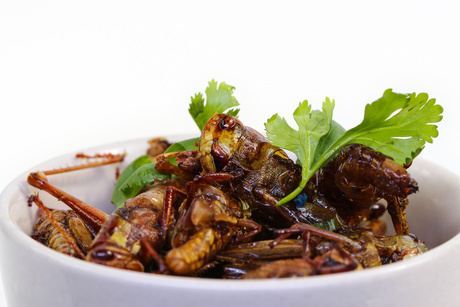Would you like crickets with that? Or why insects could be the next protein source on your plate

Will insects be the protein source of the future?
While the world population is growing, the amount of available farmland isn’t. This is ultimately going to present difficulties in meeting consumer demand for protein as the shortage of farmland will limit livestock. Aaron Dossey, PhD, founder of All Things Bugs LLC, believes that insects will provide a nutritional solution.
At the IFT15: Where Science Feeds Innovation symposium hosted by the Institute of Food Technologists (IFT) Dossey said: “We have 7 billion people now and that’s projected to be 9 billion in 2050. We’re already using a third of the land on Earth for raising livestock, and the demand for protein is growing even faster than the population, especially animal protein.”
All Things Bugs, which will produce about 11,500 kg of cricket powder this year, has received research grants for several projects related to using insects as food, including how it can alleviate childhood malnutrition. Dossey cited several properties that make it a valuable food source, including:
- Efficiency: They use less land, water, feed, energy and other resources than livestock.
- Environmentally friendly/clean: Insects create fewer greenhouse gases and are not contaminated with pesticides. They also do not have any hormones in their bodies.
- Prolific: They reproduce quickly so they can replace depleted resources.
- Biodiverse: There are millions of insect species, so it is easy to find a match to a location’s need.
- Nutritious: They have protein and omega 3s, a class of essential fatty acids that help lower cholesterol.
While the research is promising, George C Ziobro, PhD, of the US Food and Drug Administration (FDA) Center for Food Safety and Applied Nutrition, cautioned that it would not be simple to add insects to the typical diet. He cited the FDA’s requirements that all food be clean, manufactured under sanitary conditions and properly labelled. In the case of insects used in food manufacturing, that means they must be raised specifically to be used as human food, not simply taken from the outdoors, because of the risk of disease or pesticides.
“We all eat insects or insect parts. In most cases, it is accidental,” Ziobro said. “The FDA restricts the sale of insect-infested or insect-damaged foods. The vast majority of people don’t want to see part of their breakfast walk off the plate.”
This does not mean than within our lifetimes we won’t be ordering ‘spaghetti cockroachia’.
Career upskilling: from food to product development chef
Former chef Zach Baudinet decided to take his years of food experience to the next level through...
A taste of flavours on trend in 2024
Understanding the flavours, ingredients and trends that will shape what we consume is essential...
What's new on the shelf this Easter?
Paper artwork-inspired chocolate eggs, sweet chilli products on show and bite-sized Polly Waffles...












